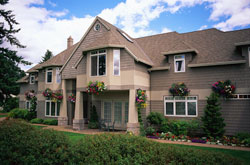A Homeowner's Guide to Green Tax Credits
See if We Have Top-Rated
Home Improvement Professionals in Your Area

Too many homeowners want to complete energy-efficient upgrades or green renovations but mistakenly believe they can't afford it. Often, the extra cost of a green home improvement is a negligible one when tax credits are considered. In some cases, these tax credits can almost cut the cost of a major green renovation in half. Of course, any home improvement requires a good deal of planning and research, but without including the calculations of these tax credits into the final cost of your project, you may be missing a golden opportunity for your home. Here is what you need to know about tax credits and where you can find specific credits that may apply to your project.
Federal Green Tax Credits
The most important thing to understand about green tax credits is that, as the term suggests, it's a credit, not a deduction. This means that rather reducing your "taxable income," these credits directly reduce the amount of money you owe the federal government. These tax credits apply in varying amounts to everything from windows, doors, insulation, roofing, and HVAC (including water heaters). Not every project qualifies, a new furnace, for example, must have an Annual Fuel Use Efficiency (AFUE) of 95 or higher. The tax credit for these green home improvements is capped at $500 and extends back to 2006. This means if you've already claimed a $500 tax credit from 2006-07, you can't receive any additional tax credits. If, however, you received a $200 tax credit in 2006, you can still receive up to $300 this year.
Separate from these "general" home improvements are high-end, renewable sources of energy, such as solar, wind, and geothermal systems. Under a different rubric altogether, these tax credits will commonly reach $2,000. In fact, the most eye-catching federal green tax credit has to be the 30% credit for photovoltaic systems. Of particular note is that of Jan. 1, 2009, the $2,000 cap for this credit has been removed. Given the possible size of such a tax credit, it's important to note that this tax credit can be used to offset your Alternative Minimum Tax liability, and unused tax credits can be carried over to the next year.
To see a comprehensive list of federal green tax credits and qualifications to receive these credits, visit www.energytaxincentives.org
State Green Tax Credits
In addition to federal tax credits, many states offer their own tax credits. Perhaps the most important thing to note about state green tax credits has more to do with budgetary trends and state constitutions than the credits themselves. Many states are facing budget deficits that require spending cuts. While the federal government is permitted to operate with a budget deficit, in general state governments are not. Thus, the current economic recession is more likely to affect or eliminate state tax credits than federal tax credits. If you live in a state that offers a generous green tax credit, you might want to keep a close eye on your state legislature and the condition of your home. In some states, such as California or New York, when you complete a project may affect whether you're able to qualify for a state tax credit.
Note: Oregon, in particular, is known for having substantial green tax credits available to both businesses and homeowners.
To see a list of green tax credits for your state, visit www.dsireusa.org
Looking for a change? We can help! Use this link for a professional
Home RemodelGreen Tax Credit Tips
- Don't assume that just because you're installing energy-efficient features to a home that you're entitled to green tax credits. Often, these tax credits are tied to certified professionals. If you're serving as your own GC or hiring someone without proper licensing, you may be unwittingly disqualifying yourself for some of these tax credits.
- Several green tax credits are given to builders/contractors, not homeowners. Talk to multiple contractors about how these tax credits may be lowering a project's cost. Some contractors are more willing than others to pass tax credits on to homeowners by offering reduced project bids.
- Similarly, look for energy-efficient appliances that frequently include rebates from commercial tax credits. Most notably, Energy-Star appliances. www.energystar.gov
- Ask your contractor about tax credits that do apply to homeowners. Chances are they know about all applicable local and state credits. When installing a major appliance, like a furnace or A/C unit, ask what appliances may help you qualify for additional tax credits.
- Be sure you understand how relative state and federal tax credits work with one another to calculate your final cost. For example, a photovoltaic roofing system might cost $22,000 before credits that include a $2,000 state tax credit and a federal tax credit of 30%. In this case, the state tax credit would bring the cost down to $20,000, then the applicable federal tax credit would be applied, creating a final project cost of $14,000.
- Don't become so focused on tax credits that you lose sight of local rebates offered through many local utility companies. In many cases, these rebates can be more beneficial than any tax credit offered through state and federal government.
- Timing matters. Many tax credits were put on hiatus in 2008 and have returned in 2009. In general, you should realize that what was true for your neighbor may not be true for you.
Marcus Pickett is a professional freelance writer for the home remodeling industry. He has published more than 600 articles on both regional and national topics within the home improvement industry.
More Tips & Advice For Your Home
- Related Articles
-
- Recent Articles

